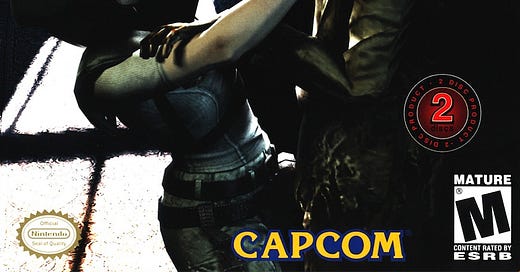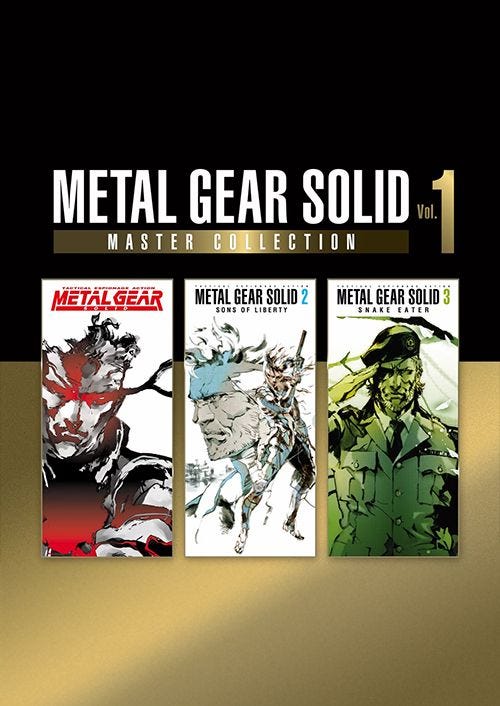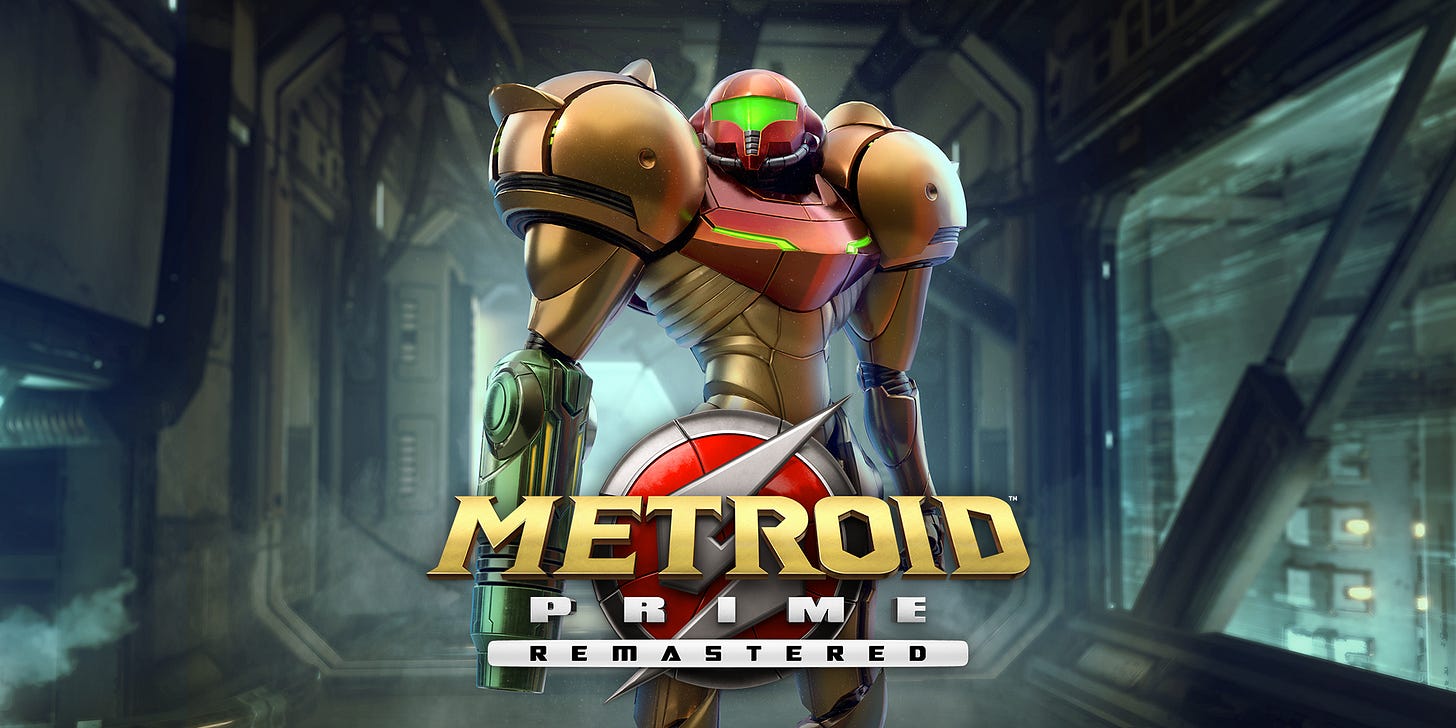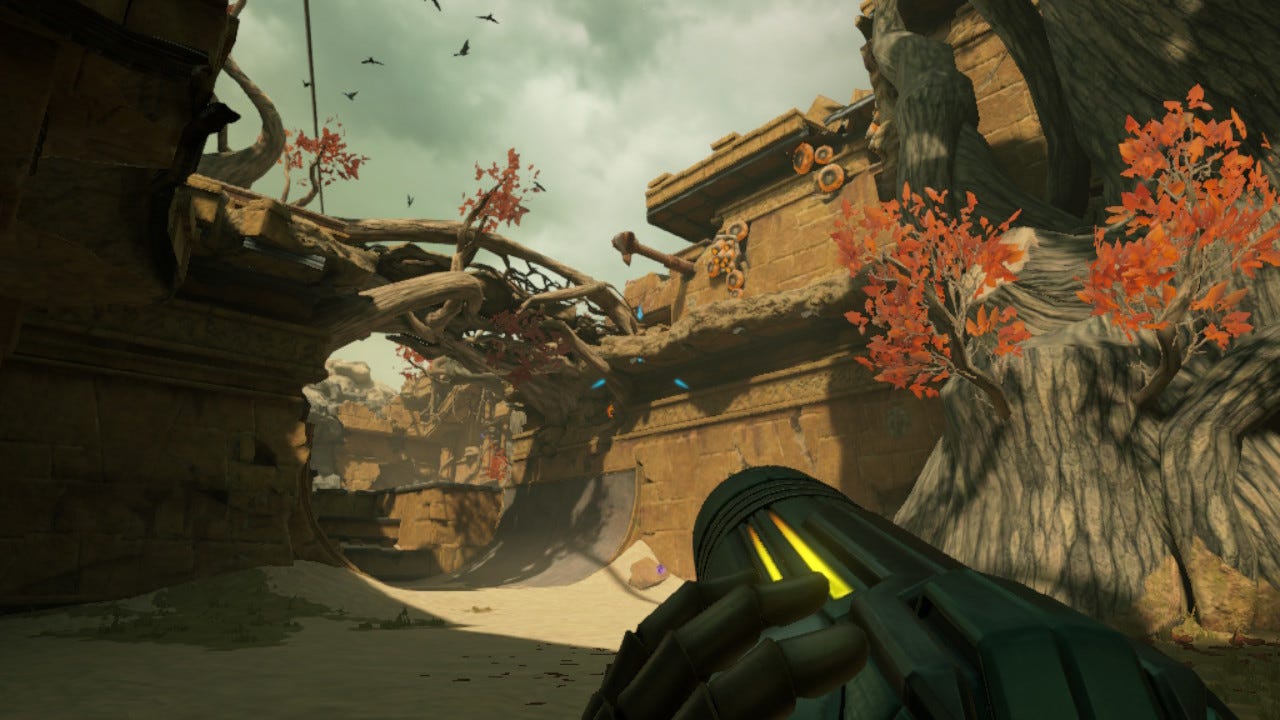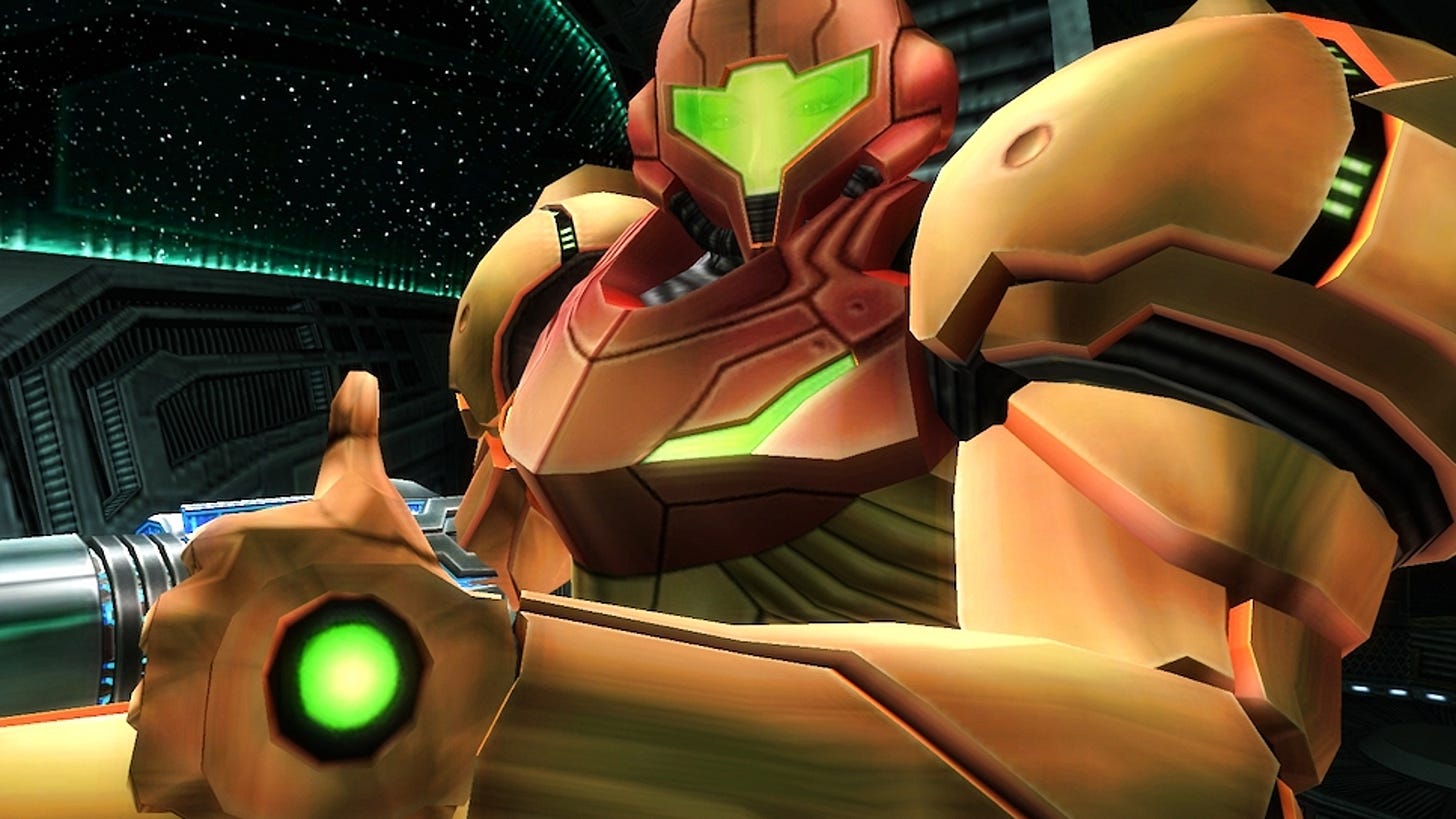Scanlines' Weekly Plays #2 (17-25th February)
Remakes and my Growing Apathy, Metroid Prime and Why a Good Community Matters
Hello everyone, I’d like to begin by celebrating the growth of this publication together. I made massive changes to the format, made a conscious effort to be more active on Notes and try to keep my writing a bit more informal and it seems to be paying off, so I thank you for restacking, liking and commenting and I hope that you and I can continue to build this platform.
I’ll take this moment too to announce the opening of my Patreon where you can contribute to the publication and get access to an exclusive Discord server and contribute to posts just like this one.
TOPIC OF THE WEEK: My Growing Apathy Towards Metal Gear Solid Delta: Snake Eater
I don’t usually like to engage in doom and gloom (and this won’t be that either) but the longer we wait to play this game, the less I care; the original Metal Gear Solid 3: Snake Eater is my favourite video game of all time, I remember playing the demo disc as a kid, I have played every single game in the series including the MSX titles, I am the textbook target audience for this game and yet… I’m beginning to not care.
I’m going to illustrate why I’m beginning to feel this way by highlighting some of the greatest remakes and remasters ever made and why I feel Metal Gear Solid Delta not only won’t live up to them but is also kind of pointless.
I’ll start with my 3rd favourite game of all time and what I think is the greatest remake of all time: Resident Evil for the Gamecube. I’ll display the North American box art because the one we receive din the PAL regions was boring.
For those unfamiliar, Resident Evil on the Gamecube (REmake as the Resident Evil fanbase often calls it) is a remake of the Playstation classic, however, more than that, it sets out to refine and rebalance the original, adding new rooms, extended lore, escape weapons for when the player is grabbed and a whole host of subversive new scares and puzzles to keep veteran players on their toes. Resident Evil on the Gamecube sets out to be the definitive version of this landmark title and I think it succeeds.
I bring this game up to deflect a criticism I’m expecting to get: that a masterpiece like Metal Gear Solid 3 cannot be improved, only tarnished. Resident Evil and Resident Evil 2 were both considered all-time greats and received fantastic remakes that arguably outshine their originals and I feel Snake Eater deserved this treatment too. A 1-1 remake, in my opinion, shows a terrible lack of ambition and creativity and I suspect fans of the original such as myself will find themselves returning to that version over Delta because when you remake the game 1-1 with modern technology and graphics, what you have is the raw experience but with none of the original charm or nostalgia.
Another example of a great remake that reimagines a lot of the original game is Metroid: Samus Returns for the 3DS.
Samus Returns was a fantastic remake of Metroid II sent to die on the 3DS in 2017 after the Switch had already launched. It’s attracted a lot of appreciation over the years for blueprinting Metroid Dread’s excellent combat mechanics and evolutions to the 2D Metroid formula.
But I mention this title because for me? When you remake a game from a franchise that has been dormant for some time like Metroid had back in 2017 and like Metal Gear Solid has for the past decade, it makes sense to look for ways to bring the series back, the trouble is that the Metal Gear Solid story has been done and dusted since 2008 and there isn’t enough timeline left to make more prequels; they could remake the MSX titles but a big part of remakes is the nostalgia and I seriously doubt there are many people reminiscing starry eyed about the original Metal Gear, even if Metal Gear 2: Solid Snake is excellent. I’m nervous about what Konami would do if they decided to try and bring Snake out of retirement and if I’ve learned anything as a fan of series like Halo, then sometimes it’s best to let the franchise go out with a bang rather than watch it using a zimmer frame, desperate to recapture former glory.
Lastly, I think Konami’s recent Metal Gear Solid Master Collection Volume I really makes this remake extra pointless.
One of the main advantages to remaking a game is that you get to repackage it for the modern era with improved performance, a higher resolution and a better framerate… but Konami have already done it!
Let me ask you this: with your $70/£70, which option sounds better? Buying a trilogy of video games, with 2 extra, fully playable on modern hardware for as low as £35-40 depending on the vendor and platform you choose to play on and saving the remaining cash or blowing the full 70 on just 1 of those games entirely remade with cutting edge graphics?
I know which one I would choose.
I love Metal Gear Solid 3, like I said, it’s my favourite video game ever but Konami has given me zero reason to care about Metal Gear Solid Delta.
GAME OF THE WEEK: Metroid Prime Remastered
I know what you’re thinking “Metroid Prime Remastered is a 1:1 remake, is this Nintendo fanboy going to act like that’s fine after railing on Konami?” And “This game came out 2 years ago, hardly retro, is it?” Well, Metroid Prime was last re-released for the Wii via the Metroid Prime Trilogy; this is a console that was made to be played on a CRT and cannot connect to modern TV’s without an HDMI converter. You can also play this version of the game on a Wii-U but let’s be honest, you don’t own a Wii-U so I feel pretty justified in saying that this was a remaster/remake that was very necessary.
And for the second question? Don’t freak out but the original Metroid Prime is almost 25 years old now.
PLOT AND PREMISE
Metroid Prime is set soon after the events of the original Metroid but it’s not necessary to have played any of the other games in the series to understand what’s happening.
In Metroid Prime you play as Samus Aran: famed bounty hunter (huntress?) as she investigates a distress signal from the Frigate Orpheon. Her adventure takes her across the planet below: Tallon IV where she recovers the components of her damaged Power Suit while investigating a primeval cosmic horror lurking beneath the planet, a prophecy from a long-extinct civilisation and the Space Pirates’ latest project endangering intergalactic security.
The game’s story and lore are delivered almost entirely through scanning corpses, computers, engravings and whatnot using Samus’ visor; Dark Souls would receive lots of praise for this kind of story telling but it’s important to give Prime its flowers as this game released almost a decade prior. The cold, analytical words of Samus’ suit computer as it describes corpses and machinery in various levels of decay and disrepair lend greatly to the game’s lonely atmosphere and light horror and piecing together what transpired before Samus’ arrival is extremely rewarding.
Unfortunately, the objects you can scan are treated almost like collectibles and some are well-hidden or not marked with the characteristic red square most scan-able objects are on your visor meaning it’s easy to miss parts of the narrative, necessitating a trip to the Wiki or a 30 minute lore video on YouTube. The game’s true ending is also locked behind 100% item completion which means finding, among other things, all 49 missile expansions, many of which are well-hidden and having such an enormous stock of missiles (250 at maximum capacity) makes this already easy game down right trivial. I’m fine with this in theory but my not seeing of this true ending actually hindered my understanding of one of Metroid Prime 2’s biggest plot points when I got round to playing it.
GRAPHICS AND PRESENTATION
I’m going to talk about the game’s updated graphical fidelity and its art style separately.
Metroid Prime is without question the best looking game on the Nintendo Switch. While it still has the characteristic Switch muddy textures, I think it matches most of the PS4’s library in visual fidelity and features a beautiful lighting engine that bathes Tallon IV in deep shadows and rich colour. Another highlight of the game’s visuals are its models which look sublime; between a few muddy textures and having poor quality character and enemy models? I think the right compromises were made.
This before and after image (which I am not taking credit for) shows the stark contrast between the old graphics and the new and on your monitor, TV or OLED screen Samus will look even better than in this compressed image.
If you’d like to grant me the ability to capture my own high-quality screenshots, consider signing up to my Patreon.
From what I understand, Prime Remastered was actually more of a remake with the team rebuilding the game from the ground up (but of course, identically to the original) the fact that they managed not only to achieve this while creating the best looking Switch game and not ruin the look and feel of the original title is nothing short of a miracle and they deserve massive applause.
I think the only complaint that I have is that some of the tiny details of the original have been lost or obscured. When Samus’ face appears in the visor after a bright flash or blinding explosion, you no longer see her squint or blink and the different visor types now create an irritating blur, obscuring the player’s vision.
But what about the game itself? Well, Metroid Prime’s presentation seeks to achieve 3 key aims: to immerse the player, to isolate the player and to convert the UI elements of a traditional Metroid game to fit a first person perspective with a greater emphasis on combat and I feel it achieves all of this but almost to a fault.
I say to a fault because while the game is deeply immersive with the edges of Samus’ helmet always on screen and each of the HUD elements slotting into perfectly readable sections of the visor, it all leads to something of a claustrophobic feeling, especially as the player’s weapon always takes up a whole quarter of the screen. Setting that aside though, Prime does a fantastic job of giving each area its own unique presentation and colour codes them on the map accordingly; never will you confuse the blue, snowy Phendrana Drifts with the sun-baked, orange Chozo Ruins. Another triumphant element of the game’s art style is just how different it manages to make the industrial areas of the space pirates feel from those of Chozo origin; I cannot imagine the effort it takes to make grey, broken down machinery look unique and thematic.
From crumbling ruins, howling winds and automated machinery loyally going about its thankless work, Metroid Prime looks and feels lonely and possesses a bleak beauty.
SOUND AND MUSIC
Metroid Prime’s soundtrack doesn’t quite reach the heights of its sequel in my opinion but this is still a Kenji Yamamoto soundtrack so it is audible gold. Mixing a lot of distorted, electronic sounds with synths and the familiar theremin droning of classic science fiction, with a few classic Super Metroid motifs scattered throughout. The soundtrack almost sounds biological at times with a lot of churning and sounds reminiscent of whale noises, I love it, it adds immensely to the game’s light horror.
My favourite pieces of music from the game have to be the iconic Phendrana Drifts theme and the battle music that plays when you encounter space pirates the latter of these embodying all the elements I described in the last paragraph.
If I had to criticise the sound and music I would say that the default Power Beam and its charged shot don’t sound particularly powerful and missiles don’t have much of an explosive sound upon impact but these are tiny nit picks.
GAMEPLAY, BALANCE AND LEVEL DESIGN
In the lead up to Metroid Prime’s release there was a lot of anxiety that it would become a Halo clone; think about it for a second, you’re in the early 2000’s and you hear that an iconic sci-fi franchise made by Nintendo has been handed to an American team who plans to make a 3D, first person entry in the series. It doesn’t sound good, does it?
Thankfully, everyone was wrong.
Metroid Prime is experienced in the first person perspective but rather than being instruments of war to mow down hundreds of enemies, its weapons are treated more as tools to unlock doors and to destroy barriers made of exotic alloys; combat is a big part of the game too of course but fighting an enemy is often some kind of puzzle where victory depends on choosing the right weapon, not shooting it 20 times with your preferred weapon. But regardless of your preferred beam or whether you choose to fire a standard or a super missile, the optional Charge Combo upgrades like the Flamethrower and the Ice Spreader and the game’s agile enemies make combat more fun than the 2D Metroids had been up to this point.
The moment to moment gameplay of Metroid Prime is exactly what you’d expect of the genre: you explore an ever expanding map, collecting upgrades along the way in order to unlock more areas but this rhythm is often broken up by some light platforming, puzzles and morph ball segments, the latter of which are so creative and enjoyable that even speaking in retrospect, I never feel the Prime Trilogy fully realised their potential in full 3D.
A highlight of the remastered version of Prime is that both the original Gamecube control scheme and the Wii control scheme are available as well as a new and improved modern control scheme. I tend to stick with the modernised one now but I also love how the Wii pointer controls play; the Gamecube scheme feels very dated but purists will appreciate it.
I like the little 3D render of the Switch in this menu too.
Metroid Prime is pretty universally loved but there are 3 major complaints that typically come up when discussing the game: the backtracking, the difficulty and Magmoor Caverns.
To cut a long story short? Sometimes you acquire an item that is used on the other side of the map; there is a hint system but it will usually only kick in after 15-20 minutes of aimless wandering. This is fine if you know the game well but I remember getting a bit frustrated when I first played this game.
Secondly, Metroid Prime is just way too easy. I played on Hard mode for this run and died only 3 times: once to the game’s penultimate boss, once in the first visit to the Phazon Mines and once to a freak accident where I was stuck up against a highly damaging hazard by the physics in morph ball mode.
Magmoor Caverns is an area whose layout is just a long fiery corridor and it connects to every major area meaning its often just used as the backtracking corridor.
These are the traditional complaints with the game and I completely agree but I would also add that the boss fights besides the final two are pretty uninspiring.
CONCLUSION
I’ve decided to nit pick Prime a lot in this review because it is so universally beloved and I don’t just want to add to that without saying anything useful but the truth is that I love this game; I prefer Prime 2: Echoes but Metroid Prime is an excellent game and Metroid Prime Remastered is the definitive way to experience it.
Tight gameplay, thick atmosphere, timeless world-building and a hard-nosed dedication to creating a living-breathing world make Metroid Prime a generational classic.
Metroid Prime 4: Beyond is out soon so if you’ve never experienced this classic for yourself then I wholeheartedly encourage you to do so and I look forward to reviewing my favourite in the series next, after February’s Monthly Scoop post.
THE WAR AGAINST NEGATIVITY
This week, a disgusting occurrence took place in the Hearts of Iron IV community.
Angered by a raft of new changes to India and a perceived sleight against their country, extreme elements within the Chinese community took to bombarding Paradox Interactive with death threats, review bombing and offensive mods uploaded to Steam Workshop.
I was heartened to see, however, that the community, even if they didn’t agree with the planned new content and changes rallied around the developers and strongly condemned the actions of these people, urging the developers not to cave to their demands and threats.
You could see this as a negative story but in my opinion, this backlash against the toxicity and racism that erupted from a only highlights that in every community, for every one bad apple there are another 10 good, sensible people who are willing to take a stand against terrible behaviour. In the modern gaming landscape, where competitive multiplayer, divisive video games and the ever-present encroachment of politics into entertainment threatens to rip communities apart it is important to always remember that there are other living, breathing human beings on the other side of your vitriol.
The gaming community likes to complain that the medium is treated like children’s toys by mainstream media but it is up to us to police our online communities so that we aren’t seen to be acting like children too. Respect is earned.
Keep playing, be well, smile, don’t be toxic.

